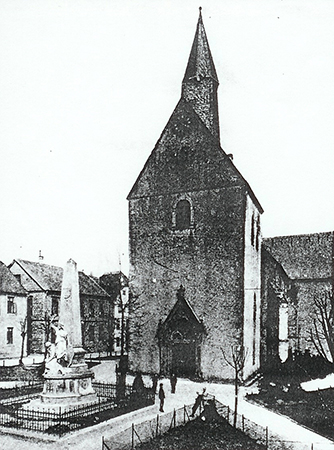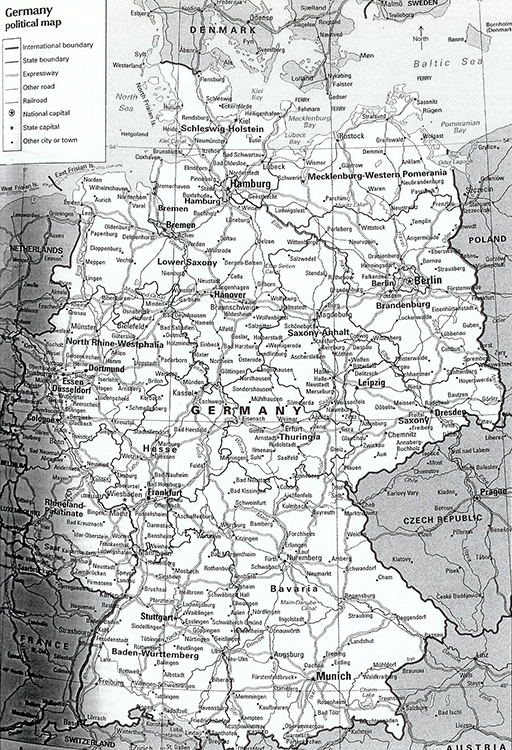

CHAPTER X
THE EARLIEST BRUNE FAMILIES
The Brune family was from the small town of Borgholzhausen which is in the west central part of Germany between Osnabrück and Bielefeld near the border of the States of Lower Saxony and North Rhine-Westphalia on the map.
Brune apparently was a common surname in the area and many Brunes have immigrated to the United States although most are not known to be related. In 2007 there are many Brune families in Missouri, but very few appear to be part of our family.
A cousin shared a wonderful booklet (written in German on the left page and English on the right page) with me, Borgholzhausener Auswanderungsgeschichte(n), History and Stories of Emigration from Borgholzhausen. In 1994 a partnership was signed between the cities of New Haven, Missouri, and Borgholzhausen, Germany. The sister city partnership laid the foundation for quite a number of close friendships between people of both sides of the Atlantic. That friendship led to this booklet being published. The following excerpts are from that booklet and describe the German emigration overseas in the 19th century, crossing the Atlantic, and the motives of the emigrants.
“The village of Borgholzhausen developed in the immediate neighbourhood of Ravensberg Castle. Its history goes back to the 9th century. In the year 1334 the village was described as a “Weichbild”. This means it was not yet a town, but at least it was given the right to appoint its own “Vorsteher” (head) and to make use of several economical privileges, which in the end contributed to the settlement of trade and handcrafts around the old “Pfarrkirche” (parish church).The people mainly lived on agriculture. But the farms were generally under the ownership of the regional nobility, in this case the Earl of Ravensberg. Thus the farmers were not the owners of the farms but the got inherited rights to utilise the farms and the land. Compensation of the rights they had to pay in the form of services to the nobles and by deliverance of products to them. After the Thirty Years War (1618–1648) a third group of rural population settled in our area, the so-called “Heuerlinge”. They belonged to the lowest level of rural people, because they did not have any land and farms. They lived in small huts and had to pay their house rent by working for the farmers. Their second and most important source of income was weaving linen. However in course of the 19th century the local home industries of spinning and weaving could not compete with the upcoming industrial production. In the end weaving at home was abolished. This had dramatic consequences for the concerned people. The “Heuerlinge” were fully dependent on agriculture, but their yields were too small, while the house rents rose due to the high demand for housing by the growing number of landless people. Finally there was no alternative, but to emigrate, mostly to the United States of America.
Emigration from Germany took place in three decisive phases with different regional concentration. Between 1817 and 1832/33 emigration was mainly limited to the southeast of Germany. Thereafter it covered the whole of Germany. The northwestern emigration slowly started in the 30th of the 19th century (meaning 1830s) and came to a preliminary peak in the 40th and 50th (meaning 1840s and 1850s). The American Civil War from 1861 to 1865 interrupted the influx of emigrants. However after the end of the war until about 1875 a second emigration wave swept over the whole of Germany. In the year 1880 a third wave started and it mainly covered the parts of Prussia lying east of the river Elbe.
In the 1850s Wilhelm Vogel ran a very successful emigration agency. In the second half of that decade almost every emigrant from Borgholzhausen made use of his services. In 1855, 26 emigrants left Borgholzhausen; 1856, 97 left; 1857, 227 left; 1858, 147 left; 1859, 53 left; and in 1860, 84 emigrated. (Our Peter Brune left in 1858.) He virtually handled every legal emigration from Borgholzhausen via Bremen to the USA. Therefore we may assume that in the second half of the 1850s the first lap of the journeys of the emigrants from Borgholzhausen generally were not troublesome but rather convenient. The experiences of the illegal emigrants were completely different. They had to organize their departure as well as their passage to America themselves because they could not make use of the travel preparations of a professional and licensed agent.
During the crossing however the passengers were left to themselves. Most of the passengers traveled in the cheap inbetween decks to America, no wonder, because hardly anyone could afford the expensive cabins. Almost everyone got seasick. The large mostly unheated and almost unfurnished room usually accommodated between 150 to 200 people. This room served them, equally as sleeping, eating, and general room. Therefore cramped conditions and filth determined the living together. The passengers in the between decks were regarded to be second class travelers and they were subject to the arbitrariness of the captain and his crew and they were separated from the cabin passengers by class differences.”


Borgholzhausen Church years ago
same Evangelisch-Lutherische Kirche Borgholzhausen, 2007

Map of Germany
— NOTES —
1 Richard Sautmann, Borgholzhausener Auswanderungsgeschichte(n), History and Stories of Emigration from Borgholzhausen, (Reihe: Kleine Reihe zur Geschichte der Stadt Borgholzhausen, Heft 5, Borgholzhausen, 2004)
© Marian McCreary 2015